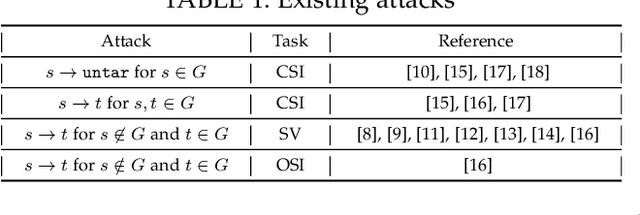AS2T: Arbitrary Source-To-Target Adversarial Attack on Speaker Recognition Systems
Paper and Code
Jun 07, 2022



Recent work has illuminated the vulnerability of speaker recognition systems (SRSs) against adversarial attacks, raising significant security concerns in deploying SRSs. However, they considered only a few settings (e.g., some combinations of source and target speakers), leaving many interesting and important settings in real-world attack scenarios alone. In this work, we present AS2T, the first attack in this domain which covers all the settings, thus allows the adversary to craft adversarial voices using arbitrary source and target speakers for any of three main recognition tasks. Since none of the existing loss functions can be applied to all the settings, we explore many candidate loss functions for each setting including the existing and newly designed ones. We thoroughly evaluate their efficacy and find that some existing loss functions are suboptimal. Then, to improve the robustness of AS2T towards practical over-the-air attack, we study the possible distortions occurred in over-the-air transmission, utilize different transformation functions with different parameters to model those distortions, and incorporate them into the generation of adversarial voices. Our simulated over-the-air evaluation validates the effectiveness of our solution in producing robust adversarial voices which remain effective under various hardware devices and various acoustic environments with different reverberation, ambient noises, and noise levels. Finally, we leverage AS2T to perform thus far the largest-scale evaluation to understand transferability among 14 diverse SRSs. The transferability analysis provides many interesting and useful insights which challenge several findings and conclusion drawn in previous works in the image domain. Our study also sheds light on future directions of adversarial attacks in the speaker recognition domain.
 Add to Chrome
Add to Chrome Add to Firefox
Add to Firefox Add to Edge
Add to Edge